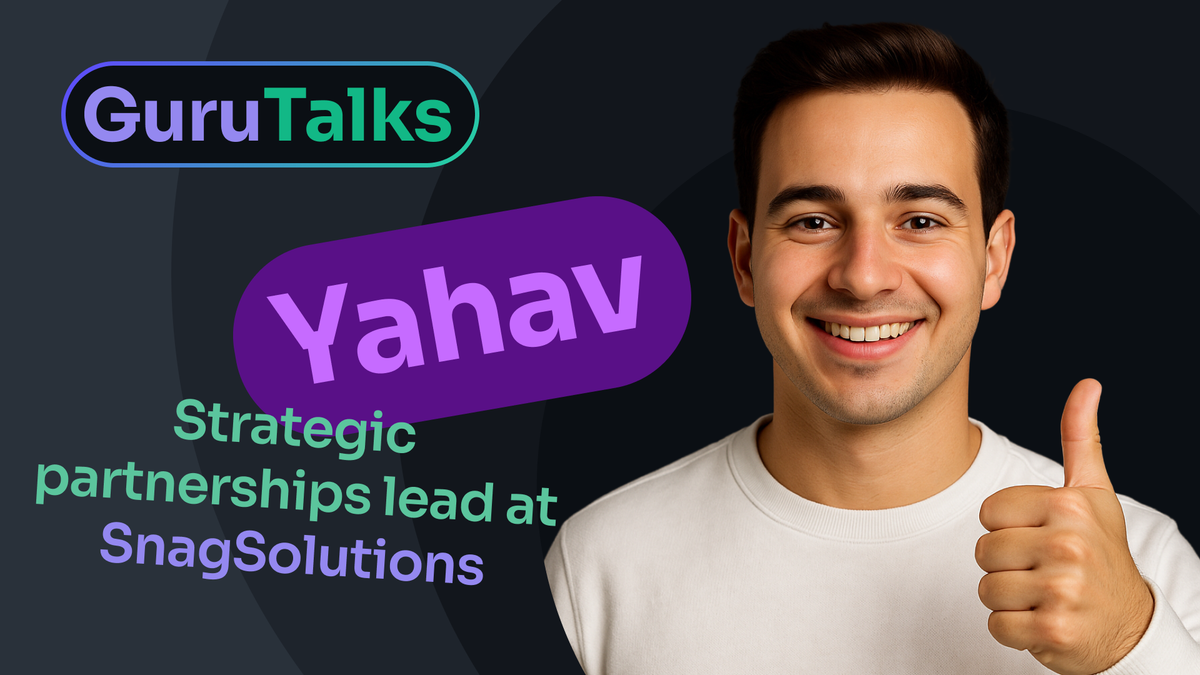Guru Talks - From Discord Roles to Million-Dollar Campaigns: How Snag Solutions is Revolutionizing Web3 Community Building
Discover how Web3 gamification and token rewards are transforming community building. Learn from Snag Solutions' expert insights on leaderboards, NFT campaigns, and anti-bot strategies that drove millions in transaction volume and 800K user growth.

The latest episode of Guru Talks brought together host Yaro from Guru Network and Yahav, Strategic Partnerships Lead at Snag Solutions, for an insightful conversation about the future of community engagement in Web3. The discussion revealed how gamification and token-based rewards are transforming how businesses connect with their audiences, moving beyond traditional marketing to create genuine value for users.
The Evolution of Community Rewards
Snag Solutions has positioned itself as a pioneer in the Web3 loyalty space, helping partners build custom growth strategies to cultivate highly engaged communities and launch sustainable tokens. With three years of experience in the field, Yahav shared how the company has evolved from a general platform to a specialized toolkit for token-based community building.
"We essentially help our partners build custom growth strategies to grow highly engaged communities and then launch or sustain valuable tokens," Yahav explained, highlighting the dual focus on both community development and tokenomics.
The conversation revealed fascinating insights into successful campaigns, including Flow Blockchain's ability to drive millions of on-chain transactions and Camp Network's remarkable growth from 1,500 to 800,000 users, ultimately leading to a $30 million Series A funding round.
Why Web3 Rewards Work Better Than Traditional Marketing
One of the most compelling aspects of the discussion was the comparison between Web2 and Web3 marketing approaches. Traditional marketing often feels like "throwing money into a black hole," as Yahav put it, with limited transparency and control over outcomes.
"In web 3 you have more control or you have better control over the reins because you can really optimize that spend by giving both you and your users full transparency in the way you do so," Yahav noted, emphasizing the enhanced accountability that blockchain technology provides.
The key difference lies in the reciprocal value creation. Instead of spending marketing budgets on platforms like Facebook, Web3 projects can directly reward their communities, creating a virtuous cycle where users become more invested in the project's success.
The Psychology of Gamification
The conversation went deep into specific mechanics that drive engagement. Leaderboards, badges, NFTs, and referral systems all play crucial roles, but their effectiveness depends on thoughtful implementation rather than simple deployment.
Yahav shared a compelling example of Apechain NFT trading campaign, where users spent hundreds of thousands of dollars in trading volume to compete for exclusive rewards like tickets to prestigious events. The secret wasn't just the valuable prizes – it was the sophisticated gamification mechanics including multipliers and collection-based leaderboards.
"The more that they traded the higher the multiplier they got. And so then they would trade more money. They would get a higher multiplier. They would hold NFTs, they would get a higher multiplier," Yahav explained, demonstrating how layered incentives create compounding engagement.
Fighting the Bot Problem
A significant portion of the discussion focused on one of Web3's biggest challenges: distinguishing between genuine users and bots. Yahav revealed that while third-party platforms often see bot rates exceeding 90%, Snag's approach reduces this to 50-60% through strategic design.
"The biggest thing that you can do really with our tools is to make sure that there is financial buy-in from a user so that is a preventative mechanic to make sure that user isn't a bot," Yahav advised, highlighting the importance of meaningful entry barriers.
The company employs sophisticated anti-sybil detection systems, running daily checks and providing partners with detailed analytics about user behavior patterns. This data-driven approach helps projects make informed decisions about token distribution and reward allocation.
Beyond Points: Building Real Communities
While points and rewards grab attention, the ultimate goal extends beyond transactional engagement. Yahav emphasized the importance of creating spaces where users can develop genuine connections and become project evangelists.
"You want to give them a home or somewhere that they can go to and spend you know a good portion of their day talking to others really becoming someone who loves what you've provided," Yahav shared, underlining the social aspect of successful Web3 communities.
This approach recognizes that the most valuable community members aren't just those who complete quests or accumulate points – they're the ones who actively contribute to discussions, support other users, and help grow the ecosystem organically.
The Future of Web3 Community Building
The conversation concluded with thoughts on how these mechanisms might eventually migrate to Web2 businesses. Banks, retailers, and other traditional companies could potentially adopt similar strategies, offering NFT rewards instead of traditional cashback or using token-based loyalty programs.
For early-stage projects without substantial budgets, Yahav suggested focusing on future token promises, seasonal NFTs, and exclusive access rights as effective alternatives to expensive prize pools.
The discussion highlighted how Web3 is fundamentally changing the relationship between businesses and their communities, moving from extraction-based models to value-sharing partnerships. As these tools become more sophisticated and accessible, we're likely to see broader adoption across industries.
Key Takeaways for Project Builders
- Start Simple: Begin with easy on-chain quests and gradually increase complexity as users progress
- Require Investment: Implement financial buy-in mechanisms to filter out bots and ensure genuine participation
- Layer Incentives: Use multipliers, badges, and seasonal rewards to create sustained engagement
- Build Community: Create spaces for users to interact with each other, not just the platform
- Measure and Iterate: Use analytics to continuously optimize reward strategies and remove bad actors
The Guru Talks episode with Yahav provided valuable insights into the rapidly evolving world of Web3 community building, demonstrating how thoughtful gamification and token-based rewards are creating new possibilities for authentic engagement and value creation.
